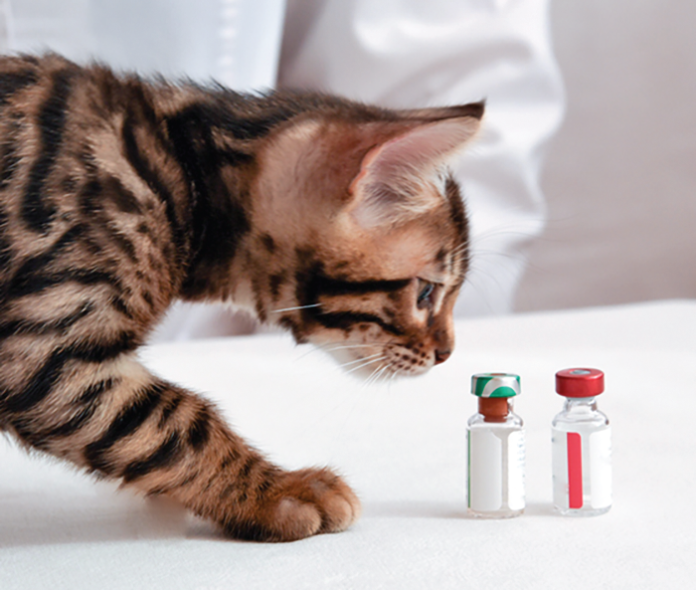Vaccines, which induce an immune response that protects against infectious diseases, are vital to good feline health. Like most medical interventions, though, they do carry some risk. For this reason, minimizing the number of vaccines that cats receive, while assuring that they are protected from the infectious diseases that they are most likely to encounter, is important.
Core vaccines refer to those that impart protection against the most common feline infectious diseases and/or that protect against diseases that can be transmitted to people. All cats should receive these core vaccines.
Non-core vaccines refer to those that provide protection against diseases that not all cats will encounter or to vaccines that have debatable effectiveness. Some cats should receive non-core vaccines in addition to core vaccines, depending upon their lifestyles. You must work with your veterinarian to determine the best vaccination plan for your cat.
Vaccinations against feline panleukopenia, feline herpes virus, and feline calicivirus are core vaccines for cats. Rabies virus vaccine, while not considered a core vaccine, may be mandated by legislation depending upon locale. Current recommendations are also to administer the first in the series of feline leukemia virus (FeLV) to kittens, and then to base recommendations for boosters against FeLV on a cat’s lifestyle (i.e., potential for exposure to cats carrying FeLV).
The effectiveness of feline immunodeficiency virus (FIV) vaccines has been brought into question, and recent evidence suggests that cats infected with FIV may live normal lifespans, so FIV vaccines are not currently recommended. Similarly, the effectiveness of feline infectious peritonitis (FIP) vaccine is questionable.
Other non-core feline vaccines include those against Bordetella bronchiseptica, Chlamydophila felis, and dermatophytosis.
Vaccines come in a number of different types. “Inactivated” vaccines refer to those that use organisms that have been “killed” so that they can induce an immune response against the organism but cannot replicate (“reproduce”) in a cat or cause disease.
In some cases, adjuvants are added to inactivated vaccines to stimulate a stronger immune response. While still the subject of debate, adjuvants have been associated with the development of feline injection-site sarcoma (FISS), a known vaccine risk. FISS is a serious type of cancer that occurs in approximately one out of every 10,000 vaccines administered to cats.
“Modified live” or “attenuated” vaccines use intact versions of organisms that have been modified so that they can replicate in a patient and induce an immune response but cannot cause disease. These vaccines basically produce an infection that does not cause symptoms but stimulates an immune response. All intranasal feline vaccines in use are modified live vaccines. Generally, modified live vaccines induce a more rapid and robust immune response than inactivated vaccines.
Another class of vaccines are called recombinant vaccines. These are produced by isolating small pieces of genetic material of the infectious organism that are then used to make small proteins that are components of the organism. These proteins induce an immune response but don’t cause disease.
Too Much of a Good Thing?
Your veterinarian will work with you to determine your cat’s risk and establish a schedule that minimizes vaccinations while ensuring your cat is protected.
If you’re concerned that your cat might be receiving too many vaccines, measuring your cat’s titers (concentration of antibodies to a particular infectious organism) may be substituted for some vaccine boosters.
Titers are obtained from your cat’s blood and provide information about the level of protective antibodies in the blood at the time the blood was drawn. Since titers can change significantly over time, though, there are some limitations to using this technology to predict protection over long periods of time. For this reason, many jurisdictions will not accept titers in lieu of rabies vaccination.
Individuals
Feline lifestyles influence which vaccines make sense. A strictly indoor cat that is never boarded, not exposed to other cats, and doesn’t travel has different vaccination needs than a cat that goes outdoors or travels. Many boarding facilities and veterinary practices have specific vaccine requirements.
Cats that may be exposed to many other cats—shelters, breeding, cat shows, feral cats, and cats in trap, neuter, and release programs—have different vaccination needs due to higher risk of exposure.
For most indoor cats, core vaccinations beginning at 8 weeks of age (12 weeks for rabies), followed by monthly boosters until 16 or 20 weeks of age is recommended. Boosters are recommended one year after this and then at three-year intervals.
Adult cats with an unknown vaccine history generally receive two doses of the vaccine given one month apart, then a yearly booster and every three years after that. For all cats, the goal is to provide adequate protection against potentially deadly infectious diseases while minimizing vaccine-associated risk.




